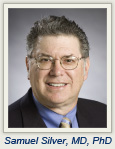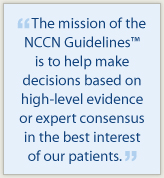 Over the past 2 decades, significant therapeutic advances have led to greater survival rates and quality of life for patients with cancer. During the same period there has been a transformation in the way oncology services are both perceived and delivered. In a recent conversation with The ASCO Post, Samuel Silver, MD, PhD, Professor of Internal Medicine, University of Michigan Medical School, and Vice Chair of the National Comprehensive Cancer Network (NCCN) Board of Directors, commented on several issues that affect the delivery of oncology services.
Over the past 2 decades, significant therapeutic advances have led to greater survival rates and quality of life for patients with cancer. During the same period there has been a transformation in the way oncology services are both perceived and delivered. In a recent conversation with The ASCO Post, Samuel Silver, MD, PhD, Professor of Internal Medicine, University of Michigan Medical School, and Vice Chair of the National Comprehensive Cancer Network (NCCN) Board of Directors, commented on several issues that affect the delivery of oncology services. NCCN’s mission is to improve the quality and effectiveness of care for patients with cancer. What value do NCCN Clinical Practice Guidelines bring to achieving that mission?
NCCN Guidelines™ have filled a huge need in the provider community, the patient community, and the payer community as well. Specifically, for oncologists and hematologists, the guidelines provide a set of evidence-based reviews integrated with expert medical judgment that address more than 95% of adult cancers.
Moreover, the consensus-based process of creating and updating the guidelines answers many of the clinical questions oncologists might have in the treatment of adult cancers, not only in areas with level 1 randomized clinical trial–based evidence, but also at the many node points in the care of these patients where that evidence level might not be so robust.
The guidelines help oncologists work through the difficult clinical problems they face on a daily basis, not only in the treatment of malignancies, but also in prevention, detection, and supportive care. If you attend tumor boards at academic institutions or in community practices, one question is often heard: “What did the NCCN Guidelines suggest at this juncture?”
Guidelines vs Pathways
Could you discuss the differences between NCCN Guidelines and some of the newer commercial clinical pathway programs?
In some ways, there may not be significant differences between the two products. For instance, one could use NCCN Guidelines to develop clinical pathways for the care of patients with cancer. However, pathways could also be developed in a narrower scope, in which they serve primarily as a cost-control mechanism stressing the use of generic cancer drugs or regimens, which could unfairly restrict the way oncologists practice.
The value of clinical pathways depends on how they are developed and written. The mission of the NCCN Guidelines is to help make decisions based on high-level evidence or expert consensus in the best interest of our patients. If commercial pathways are heavily weighted on the payer side as a cost-control mechanism, it could be cause for concern for the oncology community.
Cautionary Tale
The story of erythropoiesis-stimulating agents (ESAs) is well known. Looking back, is there a take-away message for the oncology community?
Absolutely. We saw signals based on meta-analyses that indicated a decreased survival in patients receiving ESAs, but at the time there were no good randomized trials that answered these questions definitively. At that time, the trials that were being funded by Pharma were designed to expand the use of ESAs, as opposed to better understanding the clinical implications of ESAs in terms of patient benefit or harm.
So it was more about product expansion rather than ensuring that we had the necessary data to understand whether we were giving these drugs in the right way. From a marketing point of view, if you have a successful product, you want to find ways to expand its use for other indications. But unless we have a laser-like focus on making sure that we have good data from solid studies examining current clinical use of a product, you end up with another ESA-like situation: inadequate data to answer the possibility of harm. That’s the take-away message.
Assessing Therapeutic Value
You were involved in pay-for-performance clinical trials long before the advent of comparative effectiveness research. Are we closer to having the proper methods to accurately assess value, and are guidelines a significant component for delivering value?
We actually have all the tools necessary to assess the value of various therapies. The problem is getting the funding for the trials. Studies comparing what are essentially standards of care are not attractive to Pharma. There is currently no incentive to do head-to-head trials, and you need to conduct those kinds of comparisons to show value.
That said, comparative effectiveness is the mantra du jour. The question is whether we have the fortitude to carve out the necessary funds and select which therapies and agents will be studied. New drugs and technologies are being developed each year, so another challenge will be to come up with an appropriate selection process, to ensure that our limited resources are used in the best way possible.
Doctor as Patient
At this year’s NCCN Annual Conference, you and other survivors and caregivers spoke about your personal experiences with cancer. Could you tell us a bit about that session?
 To me, what was truly enlightening about the NCCN roundtable was the focus on caregivers. Naturally, we talk about the patient and the physician, but we do not give proper attention to the role of caregivers who deal with so many of the emotional and physical needs of patients. Another interesting point that came out of the roundtable is the lack of discussion about the children of patients with cancer. We need to better understand how to talk to children about these incredibly difficult topics.
To me, what was truly enlightening about the NCCN roundtable was the focus on caregivers. Naturally, we talk about the patient and the physician, but we do not give proper attention to the role of caregivers who deal with so many of the emotional and physical needs of patients. Another interesting point that came out of the roundtable is the lack of discussion about the children of patients with cancer. We need to better understand how to talk to children about these incredibly difficult topics.
I was part of the discussion because I’m an oncologist and I’ve had a lot of experience talking to patients and caregivers during difficult times, but I also shared my experience as a cancer survivor. I was diagnosed with an aggressive form of non-Hodgkin lymphoma about 18 years ago, after I fractured my arm and went to the ER for an x-ray. The ER doc had me come back to look at my own image, and I immediately saw it was a pathologic fracture, at which point I knew I needed to see an oncologist. It was a really important moment during which I realized that I couldn’t be my own doctor and that no one is protected from cancer, not even those who treat it.
My wife, who was an amazing caregiver for me, is really the one who should have been on the roundtable. Speaking from a patient’s perspective, I realized just how important caregivers are for people battling the multitude of issues that arise with a diagnosis of cancer.
Closing Thoughts
Do you have any advice for young doctors entering the field of oncology?
From my own experience as a patient, I learned how important the initial consultation is with the oncologist. This is a seminal moment for the patient and we need to truly take the time to listen and answer questions in a thoughtful manner.
Another point I’d make is that most of us are not very good at assessing our patients’ psychiatric issues, especially when depression is more than just reactive. It’s easy to miss, so it is important to have evaluative instruments to gauge your patients’ psychological status and to have support staff intervene when appropriate.
We are in a period in which we have a multitude of new therapies that enhance our ability to tailor cancer treatments on a patient-by-patient basis. It is an exciting time of scientific discovery, but the overarching question looms: How are we going to continue to pay for these very expensive therapies. As an oncologist coming into the field, you can almost become paralyzed by this conundrum. That said, the single most important thing to remember while we advance the technical side of oncology is this: You must always place utmost value on the doctor-patient relationship; never let go of the humanity of being a doctor. ■
Disclosure: Dr. Silver serves as a consultant for Amgen and BlueCare Network of Michigan.

